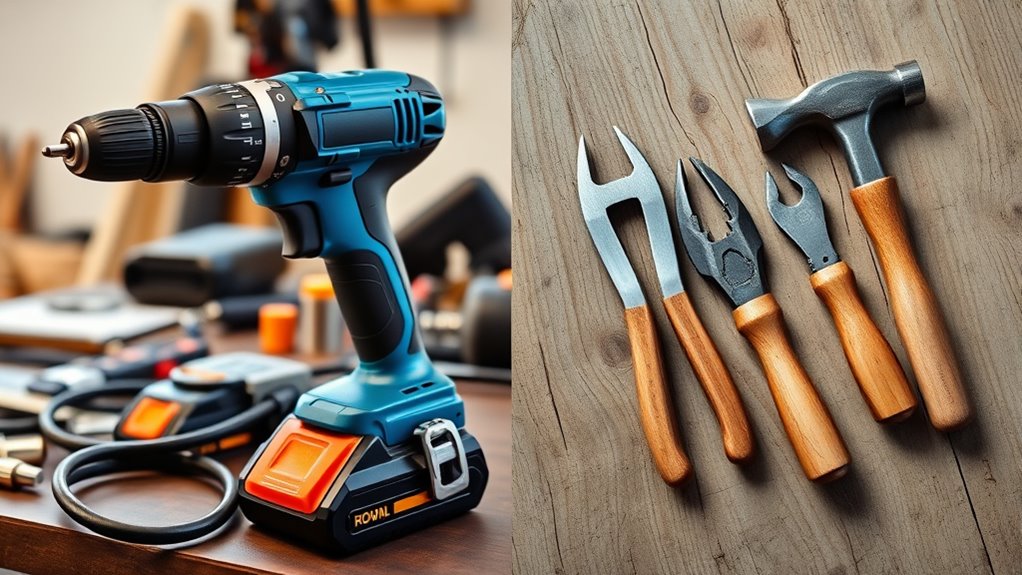Power tools speed up tasks, saving you time and reducing fatigue, while hand tools offer precision and control for delicate work. Power tools require a higher initial investment and regular maintenance, but they handle large projects efficiently. Hand tools are more affordable and easier to maintain but may take longer. Safety is essential with power tools, and choosing the right tool depends on your project’s scale and needs. Keep exploring to discover which options best suit you.
Key Takeaways
- Power tools increase efficiency and speed, ideal for large or repetitive tasks, while hand tools offer better control for detailed work.
- Hand tools are cost-effective and require minimal maintenance, whereas power tools involve higher initial costs and regular servicing.
- Power tools excel in fast completion of tough materials, but hand tools provide precision for fine, delicate tasks.
- Safety relies on proper inspection and maintenance for both, with power tools needing caution around cords and moving parts.
- Choice depends on project scope: power tools suit large-scale, quick tasks; hand tools excel in precision and tight spaces.
Efficiency and Speed
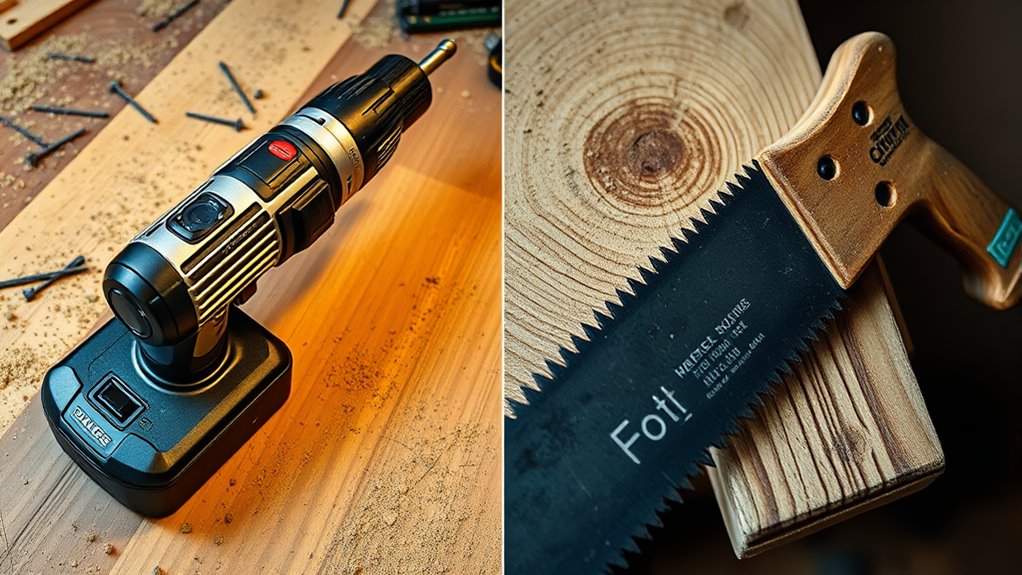
Power tools markedly boost efficiency and speed compared to hand tools, allowing you to complete tasks in a fraction of the time. Drilling holes with a power drill takes seconds, while manual drilling can take minutes or longer. Cutting wood or metal with power saws is much faster than using manual saws, especially for repetitive tasks. Power tools maintain consistent high speeds, which improves overall productivity, particularly on large projects. They also reduce physical fatigue, letting you work longer without slowing down. Tasks involving tough or dense materials are completed faster thanks to greater power output. With adjustable speeds, you can customize performance to suit each task, maximizing efficiency. Additionally, the use of airless paint sprayers can significantly accelerate painting projects by covering large surfaces quickly and smoothly. Moreover, color accuracy in power tools ensures more precise results, reducing errors and rework. Incorporating ergonomic designs can further enhance comfort and reduce strain during extended use. An understanding of material compatibility is crucial for selecting the right power tools for specific tasks, ensuring optimal performance and safety. Overall, power tools substantially cut down job durations, making them essential for speedy, high-volume work.
Precision and Control
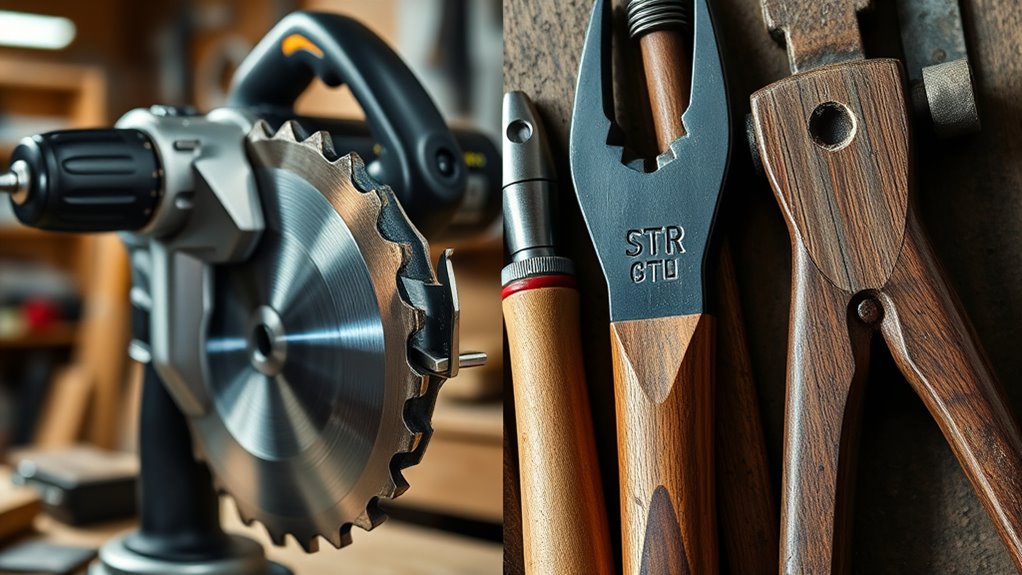
While power tools are known for their speed, hand tools excel when it comes to precision and control. They allow you to perform detailed work like carving or fine joinery with meticulous finesse. Because you can make nuanced adjustments through direct feedback, you gain better control over small-scale tasks, reducing mistakes. Hand tools are especially useful for accessing tight spaces and awkward angles that power tools might struggle with. Their lighter weight and intuitive handling make them easier to maneuver, even for extended periods. You can modulate force accurately, which prevents overcutting or damaging materials. Plus, they provide tactile feedback that helps you make real-time adjustments, ensuring smoother, cleaner finishes in delicate projects. Overall, hand tools offer unmatched control when precision matters most. Self Watering Plant Pots are designed to provide consistent moisture, which is essential for delicate or detailed work, further emphasizing the importance of control in specific applications. Additionally, the ability to exercise manual dexterity with hand tools allows for more intricate and delicate work that power tools may not achieve, especially when handling precision tasks requiring careful attention.
Cost and Maintenance
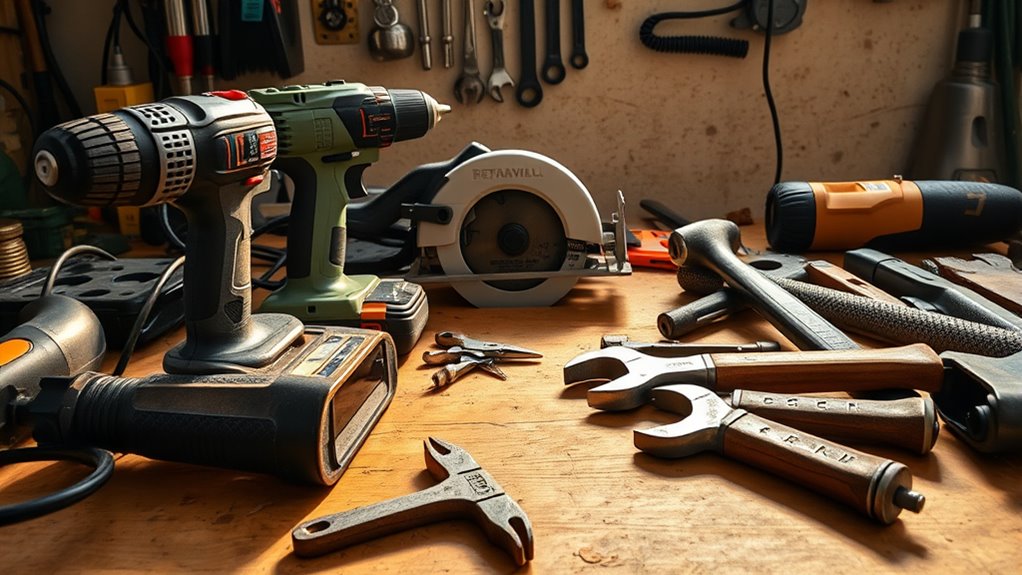
When comparing tools, you’ll find that hand tools generally cost less upfront and require less maintenance than power tools. Hand tools like hammers and screwdrivers are inexpensive, making them ideal for beginners or small projects. Power tools, on the other hand, come with a higher initial price due to their complex mechanisms and technology, such as batteries or motors. Maintenance for hand tools is minimal—mostly cleaning and sharpening—while power tools need regular servicing and part replacements. Battery-powered models add ongoing costs for battery care or replacement. Over time, hand tools tend to last decades with proper care, offering great value. Additionally, tool longevity can vary significantly between hand and power tools, influencing long-term investment decisions. For infrequent use, hand tools are the most cost-effective choice. Proper storage and care also play a crucial role in extending the lifespan of both types of tools, and understanding maintenance requirements can help prevent costly repairs or replacements. Furthermore, selecting the right tools for a specific task can greatly impact efficiency and safety during projects.
Safety Considerations
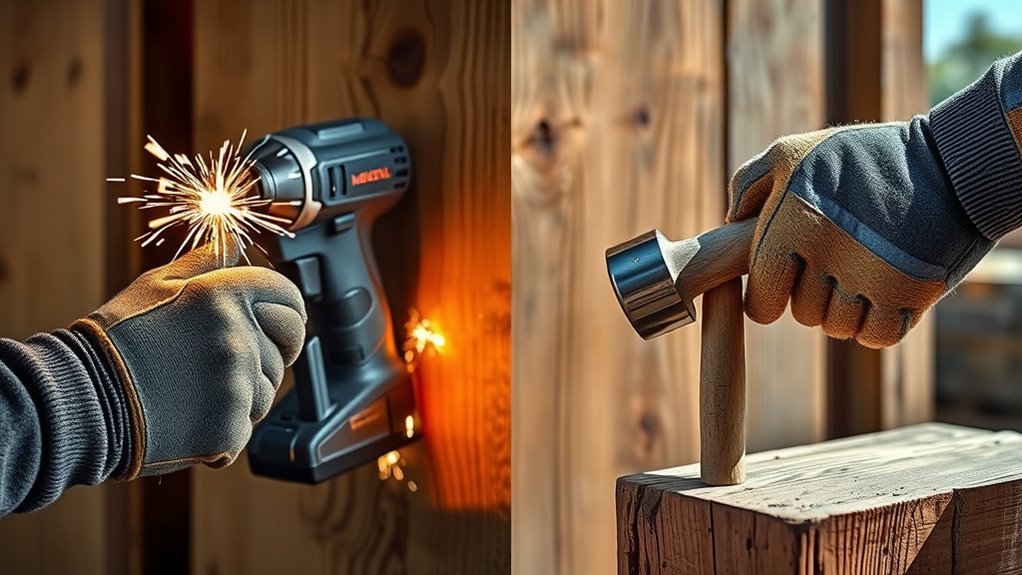
Regular inspection and maintenance of tools play a vital role in guaranteeing safety during use. You should regularly check both hand and power tools for wear, damage, or defects that could cause accidents.
Discard worn-out hand tools like hammers and saws to prevent breakage. If power tools show damage, remove them immediately and tag them clearly to avoid accidental use.
Loose screws, worn cords, or damaged parts on power tools increase electrical and safety hazards. Following manufacturer maintenance instructions reduces the risk of tool failure.
Always wear appropriate PPE, including gloves and eye protection, to guard against debris and sparks. Use the right tool for the job, keep your work area clear, and guarantee proper training.
Additionally, choosing the right tools, such as professional-grade tools, can significantly improve safety and efficiency. These steps help you maintain a safe working environment and prevent injuries.
Suitability for Different Projects
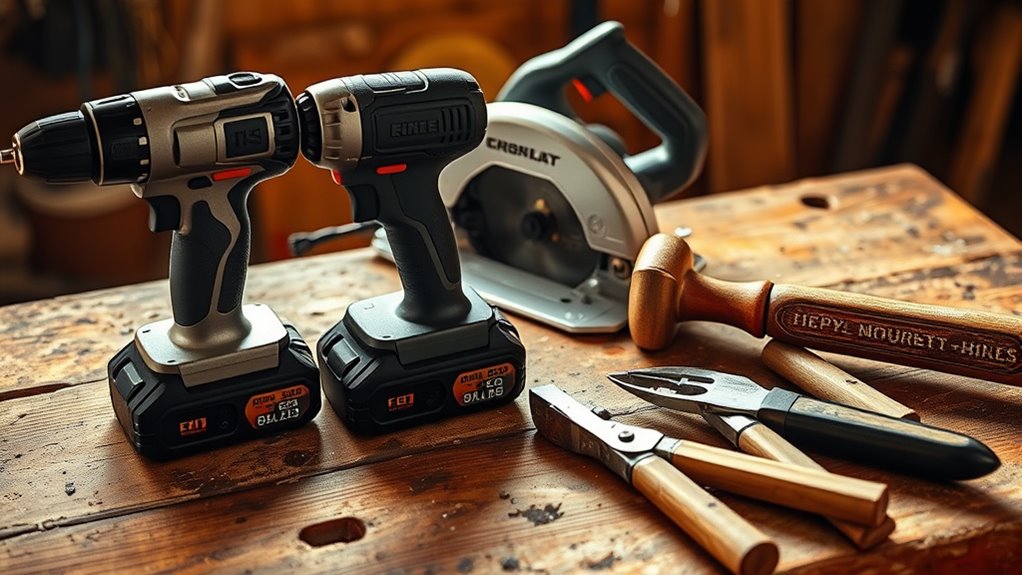
Choosing the right tools depends on the specific requirements of your project. If you need precise, delicate work like fine woodworking, hand tools give you superior control and reduce the risk of damaging materials.
For repetitive tasks such as drilling or cutting large quantities, power tools save time and maintain consistent results. Hand tools excel in tight spaces or detailed shaping, while power tools are better suited for large-scale projects like framing or demolition.
They’re also ideal for quick fixes and maintenance. Hand tools are portable and don’t rely on power sources, making them perfect for remote or outdoor jobs.
Power tools handle bigger projects efficiently but require more investment and maintenance. Select tools based on project complexity, scale, and your need for speed versus precision.
Frequently Asked Questions
How Do Power Tools Impact Long-Term Project Costs?
Power tools impact your long-term project costs by boosting efficiency and reducing labor time, which can save money overall. However, they also require higher initial investments, ongoing maintenance, and energy expenses.
If you manage tools well and use technology to optimize their use, you can offset these costs and achieve long-term savings. Proper planning ensures power tools help you finish projects faster without inflating expenses unnecessarily.
Are Hand Tools More Environmentally Friendly Than Power Tools?
You might find hand tools more environmentally friendly because they use no electricity or fuel, reducing energy consumption and emissions during use. They also require fewer resources to produce and are easier to recycle, especially if made from sustainable materials.
While they may need replacement over time, their lower carbon footprint and minimal waste generation make them a greener choice for many projects, especially small or precise tasks.
Can Power Tools Be Safely Used by Beginners?
You might think power tools are too dangerous for beginners, but with proper safety measures, you can use them safely. Always wear PPE like goggles and gloves, work in a clean, dry space, and secure your workpiece.
Take formal training and follow manufacturer instructions closely. Regularly inspect your tools, avoid electrical hazards, and stay focused.
With these precautions, you can confidently handle power tools and reduce the risk of injury.
What Are the Storage Considerations for Power Versus Hand Tools?
You should consider storage needs carefully to keep your tools safe and accessible. Power tools require more space, secure cabinets, and protection from moisture, dust, and extreme temperatures.
Hand tools are smaller, so they fit in organized drawers or racks, but still need dry, clean conditions.
Grouping tools by type and use improves efficiency. Using secure storage for expensive power tools and easy-access setups for hand tools helps maintain order and safety.
How Do Noise Levels Compare Between Power and Hand Tools?
You might notice that power tools generally produce louder noise levels, often between 85 to 120 decibels, sometimes exceeding hazardous thresholds.
Hand tools tend to be quieter, with noise levels mostly below 85 decibels, though some, like hammers, can be loud briefly.
Continuous use of power tools demands hearing protection, while hand tools, used intermittently, pose less risk.
Always be mindful of noise exposure to protect your hearing.
Conclusion
Whether you choose power tools or hand tools, consider efficiency and control, cost and maintenance, safety and suitability. Weigh the speed against precision, the convenience against craftsmanship, the upfront investment against long-term durability. By understanding the strengths and limitations of each, you can make smarter choices, match tools to projects, and complete tasks confidently. Ultimately, balancing your needs with your skills creates the perfect tool arsenal for every job.
